Why Should Food Not Be Used for Art Projects
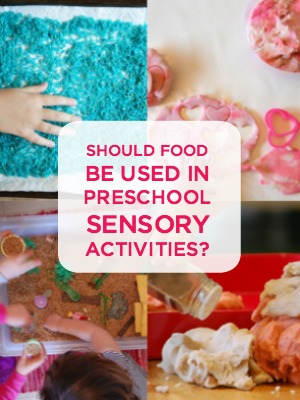 Ever since I dipped my toes into the globe of Early Childhood Education, the hotly debated issue of whether or not food should be used in preschool sensory activities has come up up multiple times. My background in the arts, where all supplies were fair game for fine art-making, didn't set me for the diverseness of opinions that circumvolve this topic.
Ever since I dipped my toes into the globe of Early Childhood Education, the hotly debated issue of whether or not food should be used in preschool sensory activities has come up up multiple times. My background in the arts, where all supplies were fair game for fine art-making, didn't set me for the diverseness of opinions that circumvolve this topic.
In that location are many proficient reasons to stay away from using food in fine art or sensory activities, and most of them apply to preschool classrooms and daycare centers where children of multiple backgrounds and nutrient sensitivities will be affected.
Possibly you're like me and haven't idea about this much until now. I encourage you to read through the thoughtful comments in this mail and come to your own conclusion.
TinkerLab reader, Pam, presented this question on Facebook after I shared a postal service for making colored rice:

And Pam's question reminded me of a question from our friend, Lori, only two weeks earlier:
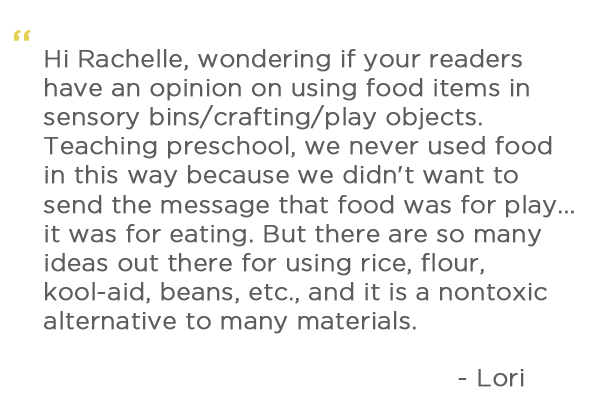
Since this question comes up a lot, I wanted to have a moment to unpack it here and share some of the pros and cons for using nutrient in toddler and preschool sensory activities. Please go on in heed that the word "preschool" tin relate to a preschool classroom setting or to the age of a preschool child who is at abode. My own answer to this question (shared below) differs according to the context.
I'd love to invite yous to share your thoughts on the topic, as it'due south quite possible that something will be left out. My goal isn't to convince you to take a stand up in one camp or the other, but to provide y'all with the tools you might need to make a decision that'due south right for your situation.
I pulled together some reader quotes from the same conversations and invited some blogging friends to chinkle in on the topic as well.
Let'south become…
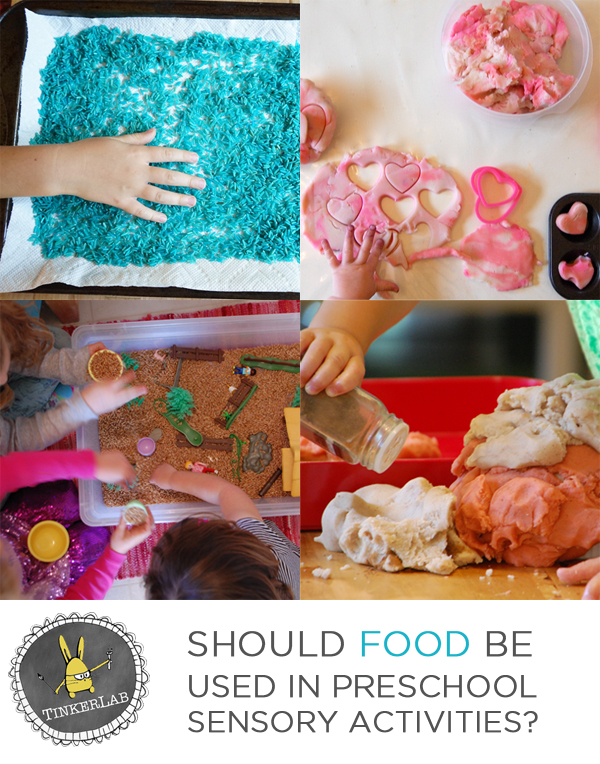
Con: Using food for Play is Insensitive and/or Wasteful
With millions of children in the globe living in poverty I think it is ignorant to use nutrient for play. Sticks, crunchy leaves, seed pod, tree slices, bark, dirt, organic sawdust, shells, minor stones, sand, water ice….. The list of non food, not toxic Gratis play alternatives are endless. Mother Nature has provided united states of america with all we need for sensory play. – Lee-Anne
When you fill your sensory table with rice or millet you are existence playful with an amount of food that could feed a family unit for weeks. It teaches children that materials are abundant, and not of any great value, things that aren't true in most of the world. In my centre we use edible materials for babies merely nosotros try hard to find means to value and honor the nutrient that we employ. – Kendra
It is not about confusing play with food you would swallow, information technology is more like using food in play every bit though information technology were cipher, when in reality in many countries out in that location, it is very expensive, heck, 1 play bin could feed a family of 4 for 2 meals in our ow n country. Nosotros practise non realize how much other people struggle and information technology is seen as wasteful. It was mentioned on my blog how many United states bloggers treat rice and beans and lentils and the similar as cipher, simply in many other areas those things are expensive. Not just underprivledged struggle either, many Americans that are at that place for the Armed Services detect those things pricey in many areas equally well…it is about being informed. – Michelle
Only know your audience. If you're working with families facing food insecurity, seeing bins or beans or rice "wasted" tin seem disrespectful. I use a lot of dried beans and dyed rice in my sensory bins, but I make certain it is ok as far as the population I'm serving first. –Sarah
Best practice means being respectful menstruation, not just the brand upwardly of your class for one particular year. –Mary
In New Zealand we don't use food ie dried pasta etc for play every bit its not Tikanga. Cultural principles around the discipline. There are many many other natural resources we employ to provide tactile play.-Sarah
Play with food at the table, in the context of eating, is ok, but playing with food for enjoyment sake itself is, in my view, a real first world ignorance. It could feed a family, possibly fifty-fifty ane in your centre, for a day and you disregard that issue with this type of play. Also, stuffing edible bean bags with dried beans, rice or other such food, is not a good idea either, for the same reasons. Many cultures keep food sacred, separate from all other activities, and with good reason. I highly suggest avoiding food-play in this way. The greatest nutrient play is getting even the youngest of children to help you lot set nutrient- my 2 yr old loves to bake, peel carrots and whisk eggs. Making games of the meal is all part of learning to relish nutrient. Hope this helps. Non-toxic toy alternatives are wool, cotton, wood, and flax, non food. – Tota
Oh my….Nutrient needs to be respected- not played with! Permit united states of america effort every bit an early babyhood customs to raise children on the concept of respecting food, where information technology comes from and how it is vital for diet. –Cathie
Information technology is a kid care regulation in my state that nutrient cannot be used in sensory tables nor art projects for the cultural and wasteful reasons others have mentioned. –18-carat
Pro: Using Food for Play is not Insensitive or Wasteful
It'southward funny how being respectful of food with children comes upwardly frequently, yet the biggest challenge facing nigh of the global population is clean drinking water. We frequently use it for "play" and for washing off surfaces. Children in some areas are deprived of a practiced function of a schoolhouse day because they walk hours to get fresh water for their families. In schools here we accept "h2o tables" and "splash pools" full of drinkable water before information technology gets used.I have no problem with staples being used for nutrient play with children. Food banks and global donations e'er contain a surplus of those items. Fruits and vegetables, dairy, and proteins are items to be avoided for food play with children. Anyone who is struggling financially has no problem putting macaroni or rice on the table. It is the other 3 food groups that are challenging. A lot of staple foods are thrown out because they accept gone stale or not eaten. Using them for educational purposes is better than discarding them.– Alan
I prefer to utilize the food scraps. Nosotros take a postal service on vegetable scrap stamping. If the nutrient is going into the disposal, the trash or the compost, and information technology presents an opportunity to acquire (either past dissecting information technology, planting it, or doing some art with it), and so it is corking to use. Information technology besides affords an opportunity to have the kids in the kitchen with me while I cook, where nosotros can do an activity together even though I'chiliad getting chores done. –Patricia, Critters and Crayons
As a history educator, I go along in mind that food items often were and are even so used in play and fine art all over. Consider, too, that the bag of rice you buy in your adult world grocery store won't otherwise exist going to someone living in hunger l. Global hunger is less due to a nutrient shortage than to war, lack of infrastructure, and a political failure of volition. Rather than take stand on a particular type of textile, I focus on existence mindful of the furnishings of our choices and the ways in which we can farther social justice. –Candace, Naturally Educational
I used a agglomeration of old macaroni that was stale for a sensory bin for my toddlers. Seeing as information technology isn't cooked, it'southward hard to recognize as "food" and I would rather employ it in some way than throw it away because it never got eaten. Plus, my 2 year old tends to put everything in his mouth and I would much rather him end upward with a dried piece of macaroni than sand or beads. –Christina
I don't concord that using food in a different way is "wasting". Information technology's beingness used, meaningfully and with great purpose. Are kids wasting finger paint? No they are using it. They are learning with information technology. It is valuable. I appreciate the demand to exist sensitive to families both socio economically and culturally only I reject the idea that use is waste.– Kawai
We relish using nutrient for our crafts and sensory play. I practice understand that it may be seen as a luxury to exist so wasteful with food – but then surely having a huge variety of newspaper, handfuls of crayons and pens and many many more than craft materials could be considered a luxury too? This may exist a little black and white for some, merely if I tin afford to buy a pack of mark pens for $5, so I can besides afford $1 for a bag of rice. –George, Craftulate
We use rice in our sensory table because we have withal to detect something that feels as wonderful. Nosotros've been using the aforementioned container of rice (we rotate) for 2 years now. Nosotros are not being wasteful with it and accept found the benefits to be wonderful. –Melanie
In regards to the food "waste matter" effect, I would argue that nutrient is non being wasted, just used in an alternative way. Is the food existence digested and giving the torso nutrients? No. Only is playing with nutrient stimulating my child'south nervous organization in ways that non-food sensory play can't? Yes. And in the long run, we'll be "wasting" much less food because my child will now consume the food we played with, rather than refusing it every time it's presented on a plate. – –Jordan, Maternity and Other Adventures
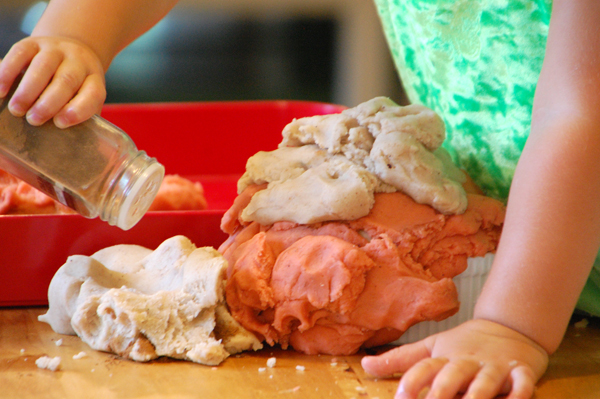
Con: Preschool Kids May exist Allergic to Sensory Activities
As well a consideration is food allergies or intolerances that may crop up in the classroom. Information technology'southward hard to have to make changes to the curriculum year to year to safely accommodate everyone and so if you tin can come up with non nutrient alternatives that may exist best. – Lissa
My girl had a dairy allergy when she was a preschooler. It was fell worrying about every potential craft or activity existence something that could harm her. I'm grateful she outgrew it, but I remember those anxiety filled days well. –Melinda
Every bit a parent of children with food intolerances, I dread any food-based activities at schoolhouse. Especially at preschool with my toddler, who is more likely to jam things into her oral cavity. In fact, when my oldest was a toddler, she viewed the sensory table as her own personal all-you-tin can-eat buffet. (This was before I knew how those ingredients affected her.)Equally a parent, I either have to promise the teacher can exclude my kid from whatever activities involving foods she'south intolerant to if there's a hazard of ingestion, or else I as the parent have to provide plenty of a prophylactic alternative for the course to utilize instead. Which can quickly go an expensive burden! I do run into the value of food-play, and it's a safe way for littler ones to have sensory play without fright of choking. It'south too a peachy way to raise audacious eaters, by having them collaborate with ingredients in multiple ways (taste, affect, smell, etc,) and by using familiar foods in different means (a lot of kids get stuck in a estrus where a food must be served the same mode every time!) So every bit long equally the instructor/school is willing to accommodate food allergies and intolerances, then I'm all for food play at school! But if a child is constantly put at take a chance or must exist excluded from an action, then that class may have to miss out on nutrient activities. –Kendra, Biting the Hand that Feeds You
Pro: It's fine if Children have no Allergies
As long as there are no food allergy issues, I'd say become for it. Kids will play with food no thing what.– Teri
I take children that put everything in their mouths. Using food made more sense than anything else considering it wasn't going to be toxic if they ate it. Information technology likewise wouldn't leave trace on their hands and was easily replenished. We reuse the food as much as possible. I take a cupboard with jars of various nutrient used in arts and crafts and play that gets brought out again and again. –Cerys, Rainy Day Mum
Pro: It'southward Helpful to Children with Sensory Needs
As a mom of a child with Sensory Processing Disorder, yes, nutrient should definitely be used in toddler and preschool sensory activities. Presenting a child with nutrient to play with, instead of consume, is a way to introduce new textures and smells without pressure. The kid is immune to explore at their own pace, and in their ain way. My son never was willing to gustatory modality pasta until after we explored cooked spaghetti in a sensory play activity. –Jordan, Motherhood and Other Adventures
My son had sensory integration issues and was merely fourteen lbs at one year. He was on a feeding tube and went to OT. At OT, do y'all know what they did? Play with food!. It really teaches them to get used to dissimilar textures and not accept an aversion to new foods. I was born during the Vietnam War and there was mass starvation when the war ended due to collectivization of the farms and bombings. I personally had to get over nutrient hoarding and being a member of the clean plate lodge. Like everything, moderation is the key. Exist respectful and don't throw the rice around, keep it in the container and try to reuse it afterwards (brand bean bags, brand maracas, stress balls in balloons, heating pads, I Spy bags, rainsticks, etc.). –Lucy
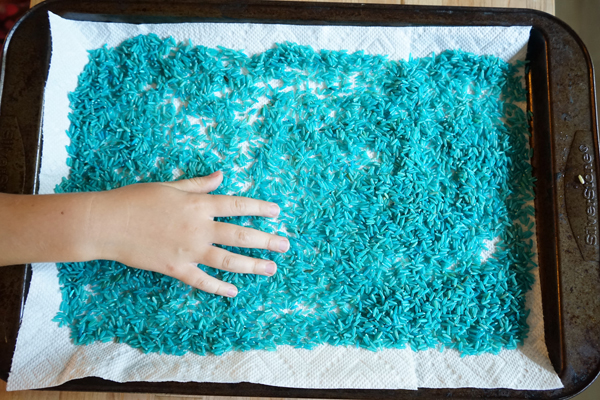
Con: Natural Objects should be left in their Surroundings
Would like to merely throw out there that it seems many who have big concerns about nutrient play are suggesting the alternative is to simply gather items from nature instead, and that idea is grand merely should exist approached with consideration to the natural world versus "free for the taking". If everyone heads outdoors to get together upwards sticks, twigs, pinecones, seeds, flowers, bawl, etc. so you've now taken food and shelter from animals who depend on us leaving these things be. Absolutely, at that place are responsible ways to acquire some natural items within reason; eastward.1000, from your own property, but typically nearly educational sites and resources do not promote this, they simply put in their lesson plans "gather upwards some pinecones and brand this glittery craft" or "swoop up flowers from a nearby field to dissect or learn fractions", etc. Squirrels and Bees would suggest possibly growing your own flowers and pick i pinecone vs. a plethora, specially if it so happens to be a weak year of natural food. I know where we live is scarce this yr due to rain last yr and the bears and wildlife are hungry searching for what they can. As well, some natural found items are federally protected resource that can state you in big problem for taking. So it really seems that providing any materials to children to play has a plus and a negative aspect to information technology. Perhaps looking at information technology altogether differently is an culling. For instance, children earthworks and growing a pocket-size garden themselves gives sensory experience whilst building an appreciation for food, besides as not taking food from wild fauna to play with. Picking and Washing the veggies also are easily on sensory experiences. Eating and preserving most whilst using a few in crafts and games much similar ancient cultures did. For example, making apple tree heads or bobbing for apples, creating corn dollies or fifty-fifty corn husk dolls. Or maybe gather natural items at a time of yr they are not and then crucial to wildlife and then returning them when needed (fall/winter). Another alternate thought from food; either human or animal, is building upward a recycling/repurposing inventory. Milk jug tops, empty cartons, squeeze bottles, jars, cans, etc. These can exist turned in to fantastic toys and play items.– Missy Louise
Pro: Food is Natural and Healthy
I used to have a problem with it, but now I think it´due south better than ownership other toys/playdough etc. Nosotros reuse the dried food/homemade playdough over and over. From an environmental view I actually recollect it´s better than a lot of plastic, battery operate d and full general toys as they are frequently fabricated with nasty chemicals, break and may end up in landfill. So I would much adopt to be letting them play with dried foods that will decompose! Kids naturally play with food at the table when they eat and I actually think it´s important to do this so that they can experience the nutrient you lot are expecting them to put in their mouths. In maxim all of this rice, flour and beans are about all we utilise (easy to store and re-use). At Christmas/easter time the odd murphy for stamping.– Felicity
I have to say I lie in the pro-nutrient camp. For me the benefits of using food in preschool activities outweigh the cons. I personally like using food because it is a less expensive alternative to many plush art supplies, considering information technology encourages children to see unique means to utilize everyday items, and because it makes for rubber, non-toxic play materials. – Ana, Babble Dabble Do
I understand the concern but do you want your children to play or accidentally ingest toxins??? I would much rather use rice or flour than something that would harm their growth, remember this is used as a learning tool and something to continue in mind using toxins what message is that sending? I am all for organic but we must understand there is a down side to this usage also. –Robin
My girls are 3 and they know not to play with food at repast time. They constantly practice food play at school and habitation…..I would rather them eat a Cheerios than a plastic bead. If they are taught to empathise (which they can do at preschool age) it shouldn't exist an issue.– Jessica
You could have food on plates that could exist played with then eaten. You could use beans for play so plant them. I'd much prefer kids playing with biodegradable products than something that'southward going to end up in the bin like the loom bands everyone has gone mad for. I remember in the scheme, of things a bag of rice is fine for play, mayhap playing with food might bring children closer to understanding and appreciating it. I've fabricated veggie critters with kids and it's a wonderful activity. –Kristy
If nosotros are non "pro-food" in sensory play, then what are nosotros? Unless yous're just then reaching for natural materials, the alternative is synthetic, manufactured items that crusade their ain environmental footprint and sense of "dispensable" waste. If properly cared for, food sensory items can exist reused again and again — the same bag of quick oats, the aforementioned batch of bootleg playdough.
Food provides unparalleled, multi-sensory engagement and is something that well-nigh people reading will have ready admission to.
Also, if the concern is having children "play with their food," I would suggest that allowing this might encourage children to be more adventurous with their food choices. Fifty-fifty painting with spices might encourage a plain-eater to effort something a bit spiced up! – Jennifer, Study at Home Mama
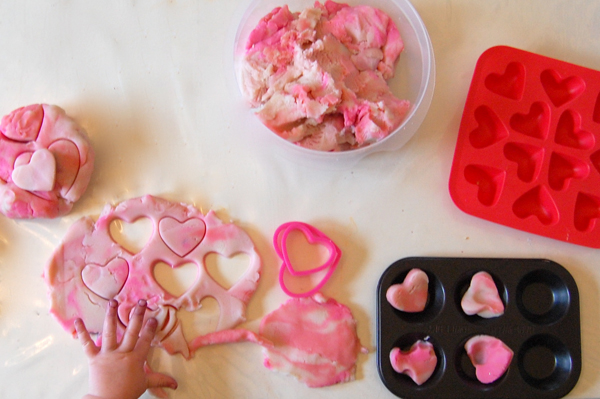
Take the Heart Footing
Gather materials from nature for your sensory bins. Rocks, pebbles, sticks, fresh cut herbs, dried plants, mud, etc! It's free, teaches about our local environment, and can exist returned outdoors or composted. Personally, I use limited amounts of nutrient ma terials. Wintertime wheat berries that we then requite to a farmer is swell in the autumn. Talk most wheats life cycle, read "little red hen", sprout wheat, talk well-nigh wheat to flour, bake some bread. All in balance friends. No sense judging one some other's practices! – April
Actually, it's nearly the balance and respect for other cultures. I practise employ nutrient, even every bit a sensory but in the context of teaching my preschoolers about cooking and diet. Giving them the independence to learn how to make something and so do information technology at home is the best lesson I can teach them. They still get to "play" / "create" with food only in a more appropriate context that they will remember and apply.– Cathryn
I personally aim to recollect carefully about any materials nosotros use in play. I want my children to have access to a wide range of materials for sensory experiences and creative prompts, and prefer open-ended, natural materials. Nosotros attempt not to use annihilation which is disposable after only ane brief apply, nosotros use as many recycled materials as possible, and we try to recycle or compost what nosotros've used afterward we have played. Using this criteria sometimes food is a meliorate choice for united states of america – for example some uncooked pasta which we might use as maths manipulatives, put in a sensory tub, and and so paint and use for art, or threading necklaces. We use information technology many times before composting information technology to do good our garden classroom. – Cathy, NurtureStore
I probably retrieve style too much about this topic. I practise concur that for some immature children using food is a safe alternative – if they tend to put things in their mouths (my son says I'1000 the most over-protective mother). Several years ago when teaching art at a preschool in a poor neighborhood information technology struck me as very sad that many o the children just ate when they got their free breakfasts and lunches at school. I imagined how i of those children would feel seeing pudding used to paint or an apple used to print. I stopped using food in my projects. I've since started again, just non in the same means. I'll employ items I would normally toss (similar strawberry tops) or I do a swap- I'll have my son cull an items to donate to the food pantry box at our grocery store if we are going to use food in an activity. I know that the 5 blueberries I'm going to use or a press project won't cause a world hunger crisis, just it makes me feel ameliorate and teaches a good lesson on helping others to do so. I explain it a little ameliorate in this post on berry fine art. –Rikki, Mini Monets and Mommies

Where does TinkerLab stand?
Equally I mentioned earlier, my background in the arts prepared me to think abstractly and broadly about what tin can be used equally an art material. When I set up my first art studio, Chris Ofili'southward paintings with elephant dung and Damien Hirst'due south real shark floating in formaldehyde took the art world by storm, demonstrating simply how far artists can push past the use of traditional art supplies. I happily made things with non-art materials similar Valentine chat hearts, resin (which comes from trees), and flowers collected from my garden. Wasn't this better, and maybe more interesting, I idea, than spending tons of money on shop-bought supplies?
Now here's an interesting fact near store-bought art supplies: Food and natural materials are frequently in the ingredients. This is something to retrieve about if you have a child with food allergies. For example: Play-doh (flour, table salt), Crayola Colored Pencils (soy), Air-dry Clay (corn starch), and Crayola Washable Markers (corn syrup). If we're to avoid food products in art so we need to consider these less obvious culprits. These ingredients aren't included in package labels and are essentially subconscious from consumers. Since food products are found in store-bought art supplies, I encounter very trivial deviation in adding food to my ain supplies.
Introducing my kids to natural materials is too far more interesting to me that exposing them to toxic materials. As such, we volition occasionally use nutrient for play or projects, and I'm more inclined to do so if it's scraps, expired, or if the play/fine art supply will last for a long time. We do our best to recycle and return things to the earth. Some of the things we accept used and made: flour and oil in cloud dough, rice flour in gluten-costless cloud dough, rice in colored rice, flour in the best play dough recipe, wheat berries in our wheat berry sensory table, and sweetened condensed milk in milk paint.
Nutrient for Play in schools: I don't run a school, but in that context there's a expert chance that I would avoid using food for play due to allergies and a desire to respect the religious and personal perspectives of a various audition. When it comes to the schoolhouse environment, I often look to my colleague, Deborah, at Teach Preschool. See the offset article, below.
More than thoughts on Food in Play
A Discussion on Food Apply in the Early Teaching Classroom, Teach Preschool
Parents and Teachers Working Together: Should Nutrient Be Used as Learning Materials, Early on Childhood News (the give-and-take in the this article is and so rich and volition give you a lot of food for thought — no pun intended!)
Play with your food? Or not? My thoughts on Food in Play, Picklebums
Being Thankful for Food, Planet Smarty Pants
Using Food in Preschool, Interaction Imagination

perkinsthrainater.blogspot.com
Source: https://tinkerlab.com/food-used-toddler-sensory-activities/
0 Response to "Why Should Food Not Be Used for Art Projects"
Postar um comentário